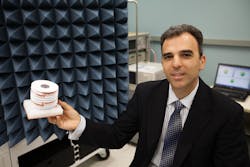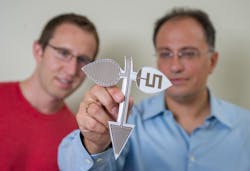Teams Apply Paper-Folding Techniques to Next-Generation Antennas
The traditional Japanese paper-folding art of origami is currently being applied to an entirely non-traditional idea: the creation of compact and efficient antennas. Researchers at Florida International University (FIU) and Georgia Technology Research Institute (GTRI) have joined forces to work toward the development of unique antenna shapes. When folded flat, they only take up a couple of centimeters. Yet these antennas can expand into much larger spaces to provide powerful, ultra-broadband capabilities.
This file type includes high resolution graphics and schematics when applicapable.
Support for this research is provided by a $2-million grant from the National Science Foundation. The teams are led by Stavros Georgakopoulos, assistant professor at FIU’s Department of Electrical and Computer Engineering, and Manos Tentzeris, a professor in the Georgia Tech School of Electrical and Computer Engineering. Like traditional origami, this approach uses paper. To create antenna elements with the necessary capabilities, an inkjet printing technique is used to deposit conductive materials, such as copper or silver, onto the paper. Other materials also are being explored for use, such as plastics, fabrics, carbon fibers, and flexible dielectrics and organics.
Various self-activation mechanisms are being studied that would allow the antennas to rapidly unfold in response to incoming signals—without the use of electronics or electrical power. One potential solution—the harvesting of ambient electromagnetic energy in the air—has already shown promise. Tentzeris’ team recently demonstrated that antenna deployment could be powered by built-in circuits, which collect energy from ambient airborne signals provided by TVs and radios. Another potential approach uses chemicals that produce movement in ways that mimic nature, such as plants unfolding in response to light stimuli.
Currently, the teams are challenged by the need to maximize the number of shapes that can be achieved in a single folding structure. Mathematicians are developing derivatives of classic origami principles that could result in the formation of 16, 32, 64, or more different types of antennas from a single device that is less than one square inch when folded. The key advantage of collapsibility is ideal for a variety of applications where traditional, large-scale antennas are not an option. This includes a range of both military and commercial uses, such as communications equipment, wireless sensors, health-monitoring sensors, and portable medical equipment.
About the Author
Iliza Sokol
Associate Digital Editor
Iliza joined the Penton Media group in 2013 after graduating from the Fashion Institute of Technology with a BS in Advertising and Marketing Communications. Prior to joining the staff, she worked at NYLON Magazine and a ghostwriting firm based in New York.


